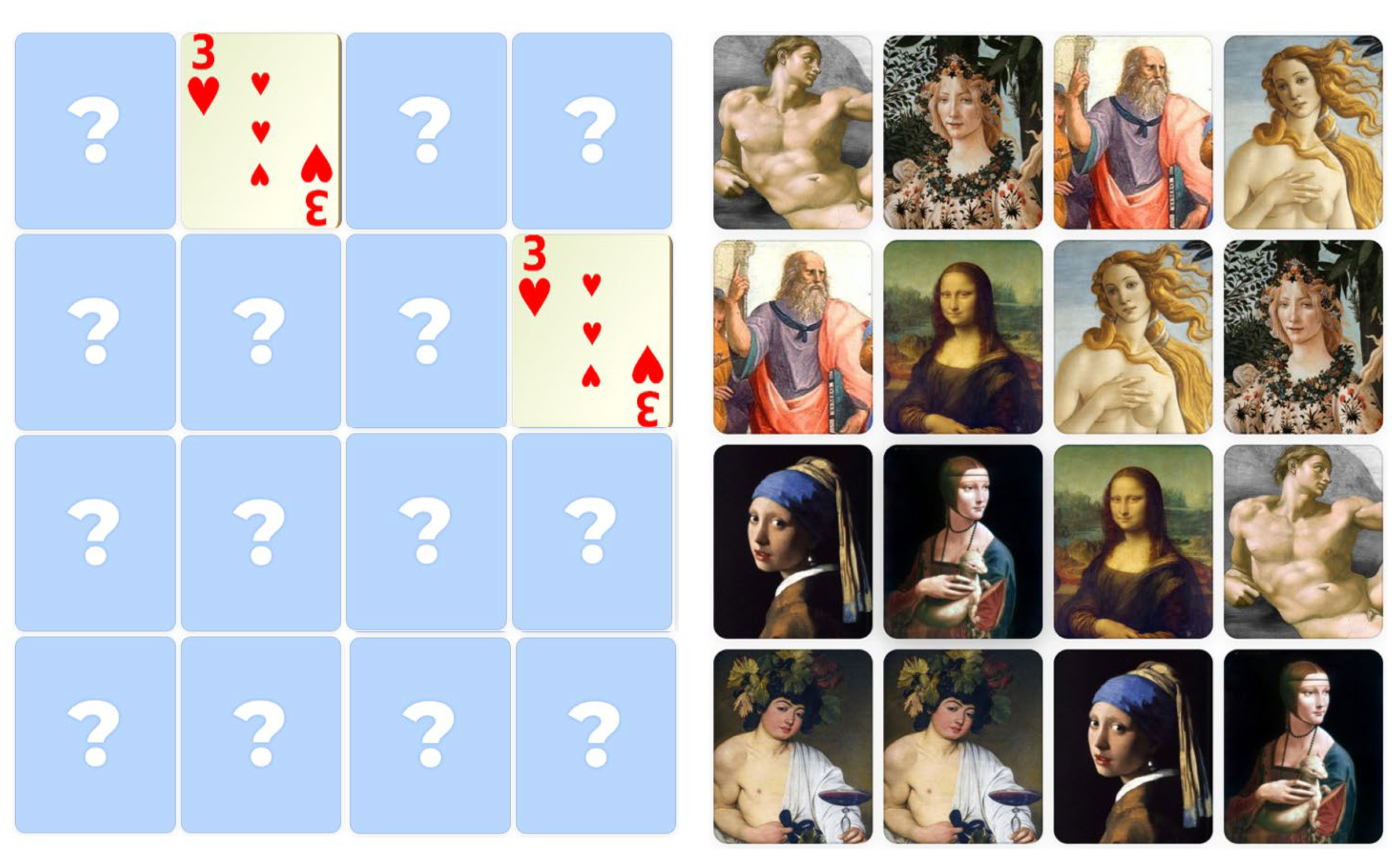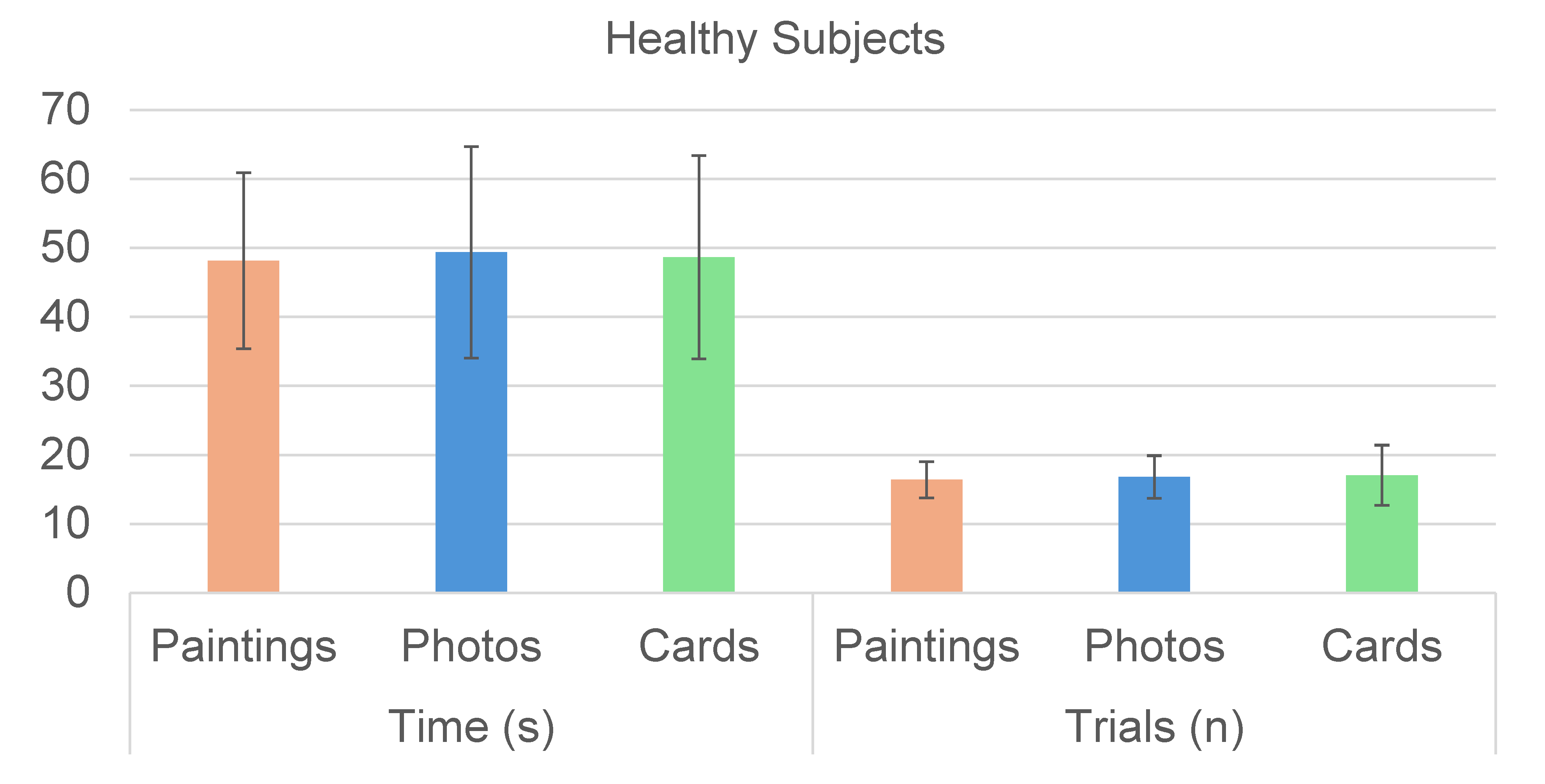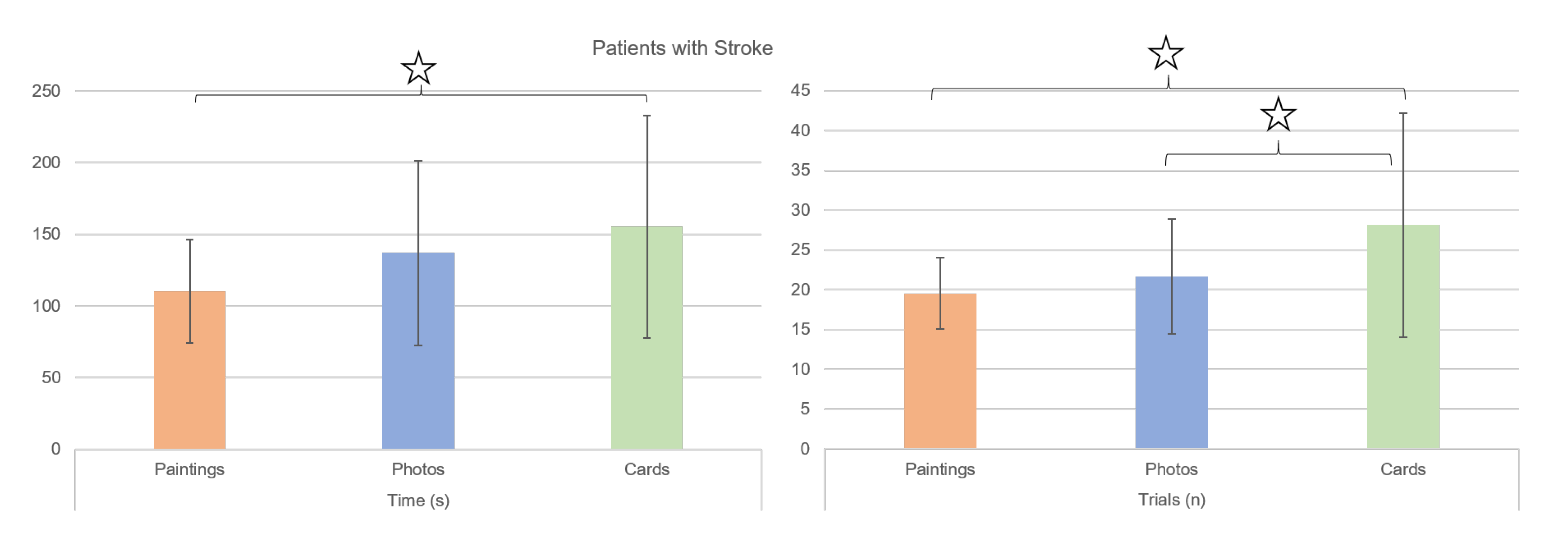Submitted:
16 April 2024
Posted:
16 April 2024
You are already at the latest version
Abstract
Keywords:
1. Introduction
2. Materials and Methods
2.1. Memory Serious Exergame
2.2. Experiment 1: Usability of the System
2.3. Experiment 2: Tests on Patients
2.4. Ethical Approval and Informed Consent
2.5. Statistical Analyses
3. Results
3.1. Experiment 1: Usability of the System
3.2. Experiment 2: Tests on Patients
| Patients | Paintings | Photos | Cards | F(2,14) | p-value | η p 2 | |
|---|---|---|---|---|---|---|---|
| USEQ | Experienced enjoyment | 4.8± 0.6 | 4.6± 0.6 | 4.6±0.6 | 2.55 | 0.108 | 0.137 |
| Successful use | 4.3±1.0 | 4.4±1.1 | 4.3±1.2 | 0.08 | 0.794 | 0.005 | |
| Ability to control | 4.6±0.8 | 4.5±0.9 | 4.5±0.9 | 2.13 | 0.135 | 0.118 | |
| Clarity of information | 4.9± 0.2 | 4.9±0.2 | 4.9±0.2 | 0.01 | 0.999 | 0.001 | |
| Discomfort | 1.0±0.2 | 1.1±0.3 | 1.2±0.4 | 2.55 | 0.108 | 0.137 | |
| Perceived utility | 4.7±0.6 | 4.6±0.6 | 4.6±0.6 | 2.13 | 0.135 | 0.118 | |
| NASA- TLX | Mental demand | 22.8±23.7 | 19±25.5 | 25.3±28.7 | 0.50 | 0.580 | 0.030 |
| Physical demand | 4.3±16.9 | 0.2±0.4 | 0.2±0.4 | 1.00 | 0.379 | 0.059 | |
| Temporal Demand | 5.4±12.6 | 3.2±6.5 | 2.5±5.5 | 0.67 | 0.438 | 0.040 | |
| Satisfaction | 74.4±27.8 | 74.7±28.1 | 71.3±29.5 | 0.56 | 0.536 | 0.034 | |
| Effort | 6.9±16.9 | 17.5±24.3 | 15.4±22.8 | 3.98 | 0.033 | 0.199 | |
| Frustration | 0.8±2.4 | 2.0±5.2 | 4.2±8.1 | 2.21 | 0.150 | 0.121 | |
3.3. Experiment 2: Correlations
4. Discussion
Author Contributions
Funding
Institutional Review Board Statement
Informed Consent Statement
Data Availability Statement
Acknowledgments
Conflicts of Interest
References
- Fancourt, D.; Finn, S. What is the Evidence on the Role of the Arts in Improving Health and Well-Being? A Scoping Review; WHO Regional Office for Europe: Copenhagen, Denmark, 2019.
- Adolphs, R., Damasio, H., Tranel, D., Cooper, G., and Damasio, A. R. (2000). A role for somatosensory cortices in the visual recognition of emotion as revealed by three-dimensional lesion mapping. J. Neurosci. 20, 2683–2690.
- Di Dio, C., Ardizzi, M., Massaro, D., Di Cesare, G., Gilli, G., Marchetti, A., et al. (2016). Human, nature, dynamism: the effects of content and movement perception on brain activations during the aesthetic judgment of representational paintings. Front. Hum. Neurosci. 9:705. [CrossRef]
- Freedberg, D., and Gallese, V. (2007). Motion, emotion and empathy in esthetic experience. Trends Cogn. Sci. 11, 197–203.
- Raglio, A., Panigazzi, M., Colombo, R., Tramontano, M., Iosa, M., Mastrogiacomo, S., Baiardi, P., Molteni, D., Baldissarro, E., Imbriani, C., Imarisio, C., Eretti, L., Hamedani, M., Pistarini, C., Imbriani, M., Mancardi, G. L., Caltagirone, C. (2021). Hand rehabilitation with sonification techniques in the subacute stage of stroke. Scientific reports, 11(1), 7237.
- Iosa, M., Aydin, M., Candelise, C., Coda, N., Morone, G., Antonucci, G., Marinozzi, F., Bini, F., Paolucci, S., Tieri, G. (2021). The Michelangelo Effect: Art Improves the Performance in a Virtual Reality Task Developed for Upper Limb Neurorehabilitation. Frontiers in psychology, 11, 611956.
- Iosa, M., Bini, F., Marinozzi, F., Antonucci, G., Pascucci, S., Baghini, G., Guarino, V., Paolucci, S., Morone, G., Tieri, G. (2022). Inside the Michelangelo effect: The role of art and aesthetic attractiveness on perceived fatigue and hand kinematics in virtual painting. PsyCh journal, 11(5), 748–754.
- De Giorgi, R., Fortini, A., Aghilarre, F., Gentili, F., Morone, G., Antonucci, G., Vetrano, M., Tieri, G., Iosa, M. (2023). Virtual Art Therapy: Application of Michelangelo Effect to Neurorehabilitation of Patients with Stroke. Journal of clinical medicine, 12(7), 2590.
- Gibson, E., Koh, C. L., Eames, S., Bennett, S., Scott, A. M., Hoffmann, T. C. (2022). Occupational therapy for cognitive impairment in stroke patients. The Cochrane database of systematic reviews, 3(3), CD006430.
- Maggio, M. G., De Bartolo, D., Calabrò, R. S., Ciancarelli, I., Cerasa, A., Tonin, P., Di Iulio, F., Paolucci, S., Antonucci, G., Morone, G., Iosa, M. (2023). Computer-assisted cognitive rehabilitation in neurological patients: state-of-art and future perspectives. Frontiers in neurology, 14, 1255319.
- Zucchella, C., Capone, A., Codella, V., Vecchione, C., Buccino, G., Sandrini, G., Pierelli, F., Bartolo, M. (2014). Assessing and restoring cognitive functions early after stroke. Functional neurology, 29(4), 255–262.
- Prokopenko, S.V., Bezdenezhnykh, A.F., Mozheyko, E.Y. et al. (2019) Effectiveness of Computerized Cognitive Training in Patients with Poststroke Cognitive Impairments. Neurosci Behav Physi 49, 539–543.
- Silva da Cunha, S.N., Travassos Junior, X.L., Guizzo, R. et al. The digital memory game: an assistive technology resource evaluated by children with cerebral palsy. Psicol. Refl. Crít. 29, 5 (2016). [CrossRef]
- Lopatina, O. L., Komleva, Y. K., Gorina, Y. V., Higashida, H., Salmina, A. B. (2018). Neurobiological Aspects of Face Recognition: The Role of Oxytocin. Frontiers in behavioral neuroscience, 12, 195.
- Massaro, D., Savazzi, F., Di Dio, C., Freedberg, D., Gallese, V., Gilli, G., Marchetti, A. (2012). When art moves the eyes: a behavioral and eye-tracking study. PloS one, 7(5), e37285.
- Pascucci, S., Forte, G., Angelini, E., Marinozzi, F., Bini, F., Antonucci, G., Iosa, M., & Tieri, G. (2024). Michelangelo Effect in Virtual Sculpturing: Prospective for Motor Neurorehabilitation in the Metaverse. Journal of cognition, 7(1), 17. [CrossRef]
- Vidal, E., Castro-Gutierrez, E., Arisaca, R., Paz-Valderrama, A., & Albiol-Pérez, S. (2023). Serious Game for Fine Motor Control Rehabilitation for Children With Epileptic Encephalopathy: Development and Usability Study. JMIR formative research, 7, e50492. [CrossRef]
- Rickenbacher-Frey, S., Adam, S., Exadaktylos, A. K., Müller, M., Sauter, T. C., & Birrenbach, T. (2023). Development and evaluation of a virtual reality training for emergency treatment of shortness of breath based on frameworks for serious games. GMS journal for medical education, 40(2), Doc16. [CrossRef]
- Vidal, E., Castro-Gutierrez, E., Arisaca, R., Paz-Valderrama, A., & Albiol-Pérez, S. (2023). Serious Game for Fine Motor Control Rehabilitation for Children With Epileptic Encephalopathy: Development and Usability Study. JMIR formative research, 7, e50492. [CrossRef]
- Demeyere, N., Riddoch, M. J., Slavkova, E. D., Bickerton, W. L., & Humphreys, G. W. (2015). The Oxford Cognitive Screen (OCS): validation of a stroke-specific short cognitive screening tool. Psychological assessment, 27(3), 883–894. [CrossRef]
- Iosa, M., Demeyere, N., Abbruzzese, L., Zoccolotti, P., & Mancuso, M. (2022). Principal Component Analysis of Oxford Cognitive Screen in Patients With Stroke. Frontiers in neurology, 13, 779679. [CrossRef]
- Clegg, F., & Warrington, E. K. (1994). Four easy memory tests for older adults. Memory (Hove, England), 2(2), 167–182. [CrossRef]
- Demeyere, N., Riddoch, M. J., Slavkova, E. D., Jones, K., Reckless, I., Mathieson, P., & Humphreys, G. W. (2016). Domain-specific versus generalized cognitive screening in acute stroke. Journal of neurology, 263(2), 306–315. [CrossRef]
- Shendyapina, M., Kuzmina, E., Kazymaev, S., Petrova, A., Demeyere, N., & Weekes, B. S. (2019). The Russian version of the Oxford Cognitive Screen: Validation study on stroke survivors. Neuropsychology, 33(1), 77–92. [CrossRef]
- Robotham, R. J., Riis, J. O., & Demeyere, N. (2020). A Danish version of the Oxford cognitive screen: a stroke-specific screening test as an alternative to the MoCA. Neuropsychology, development, and cognition. Section B, Aging, neuropsychology and cognition, 27(1), 52–65. [CrossRef]
- Huygelier, H., Schraepen, B., Demeyere, N., & Gillebert, C. R. (2020). The Dutch version of the Oxford Cognitive Screen (OCS-NL): normative data and their association with age and socio-economic status. Neuropsychology, development, and cognition. Section B, Aging, neuropsychology and cognition, 27(5), 765–786. [CrossRef]
- Gardner, H. (1993). Multiple intelligences: The theory in practice. New York: Basic Books.
- Gardner, H. (2017). Taking a multiple intelligences (MI) perspective. Behav. Brain Sci. 40:e203. [CrossRef]
- Morris, J. H., Kelly, C., Toma, M., Kroll, T., Joice, S., Mead, G., Donnan, P., & Williams, B. (2014). Feasibility study of the effects of art as a creative engagement intervention during stroke rehabilitation on improvement of psychosocial outcomes: study protocol for a single blind randomized controlled trial: the ACES study. Trials, 15, 380. [CrossRef]
- Sit, J. W. H., Chan, A. W. H., So, W. K. W., Chan, C. W. H., Chan, A. W. K., Chan, H. Y. L., Fung, O. W. M., & Wong, E. M. L. (2017). Promoting Holistic Well-Being in Chronic Stroke Patients Through Leisure Art-Based Creative Engagement. Rehabilitation nursing: the official journal of the Association of Rehabilitation Nurses, 42(2), 58–66. [CrossRef]
- Jaywant, A., & Keenan, A. (2024). Pathophysiology, Assessment, and Management of Post-Stroke Cognitive Impairment, Depression, and Fatigue. Physical medicine and rehabilitation clinics of North America, 35(2), 463–478. [CrossRef]
- Mancuso, M., Iosa, M., Abbruzzese, L., Matano, A., Coccia, M., Baudo, S., Benedetti, A., Gambarelli, C., Spaccavento, S., Ambiveri, G., Megna, M., Tognetti, P., Maietti, A., Rinaldesi, M. L., Gamberini, G., Varalta, V., Morone, G., Ciancarelli, I., & CogniReMo Study Group (2023). The impact of cognitive function deficits and their recovery on functional outcome in subjects affected by ischemic subacute stroke: results from the Italian multicenter longitudinal study CogniReMo. European journal of physical and rehabilitation medicine, 59(3), 284–293. [CrossRef]
- Van Lith, T., Schofield, M. J., & Fenner, P. (2013). Identifying the evidence-base for art-based practices and their potential benefit for mental health recovery: a critical review. Disability and rehabilitation, 35(16), 1309–1323. [CrossRef]
- Kongkasuwan, R., Voraakhom, K., Pisolayabutra, P., Maneechai, P., Boonin, J., & Kuptniratsaikul, V. (2016). Creative art therapy to enhance rehabilitation for stroke patients: a randomized controlled trial. Clinical rehabilitation, 30(10), 1016–1023. [CrossRef]
- Liu, S., Huang, X., Liu, Y., Yue, J., Li, Y., & Chen, L. (2024). A scoping review of the use of creative activities in stroke rehabilitation. Clinical rehabilitation, 38(4), 497–509. [CrossRef]



| Healthy Subjects | Paintings | Photos | Cards | F(2,14) | p-value | η p 2 | ||
|---|---|---|---|---|---|---|---|---|
| USEQ | Experienced enjoyment | 4.4±1.1 | 4.1±0.9 | 4.2±0.7 | 1.20 | 0.315 | 0.079 | |
| Successful use | 4.9±0.3 | 4.7±0.6 | 4.7±0.6 | 1.00 | 0.370 | 0.067 | ||
| Ability to control | 4.6±0.7 | 4.8±0.6 | 4.6±0.7 | 1.31 | 0.282 | 0.086 | ||
| Clarity of information | 4.9±0.3 | 4.9±0.4 | 4.7±0.8 | 0.68 | 0.440 | 0.047 | ||
| Discomfort | 1.3±0.8 | 1.3±0.8 | 1.2±0.8 | 1.00 | 0.381 | 0.067 | ||
| Perceived utility | 4.3±1.2 | 4.3±1.1 | 4.4±1.1 | 0.16 | 0.839 | 0.011 | ||
| NASA-TLX | Mental demand | 42.0±20.6 | 40.3±22.2 | 38.3±25.0 | 0.46 | 0.621 | 0.032 | |
| Physical demand | 13.5±17.7 | 15.6±20.0 | 9.9±10.5 | 1.39 | 0.263 | 0.090 | ||
| Temporal Demand | 20.1±19.2 | 27.2±23.0 | 15.3±14.8 | 2.11 | 0.148 | 0.131 | ||
| Satisfaction | 64.4±22.6 | 65.1±21.0 | 62.0±20.5 | 0.22 | 0.801 | 0.016 | ||
| Effort | 40.0±26.5 | 35.5±21.6 | 41.2±22.8 | 0.55 | 0.558 | 0.038 | ||
| Frustration | 8.3±9.5 | 8.9±10.3 | 8.5±9.7 | 0.10 | 0.853 | 0.007 | ||
Disclaimer/Publisher’s Note: The statements, opinions and data contained in all publications are solely those of the individual author(s) and contributor(s) and not of MDPI and/or the editor(s). MDPI and/or the editor(s) disclaim responsibility for any injury to people or property resulting from any ideas, methods, instructions or products referred to in the content. |
© 2024 by the authors. Licensee MDPI, Basel, Switzerland. This article is an open access article distributed under the terms and conditions of the Creative Commons Attribution (CC BY) license (http://creativecommons.org/licenses/by/4.0/).





